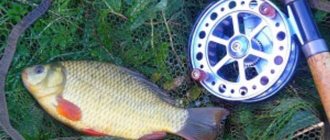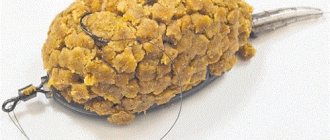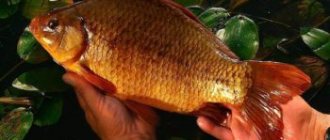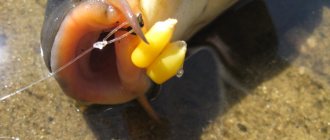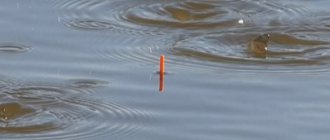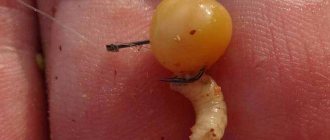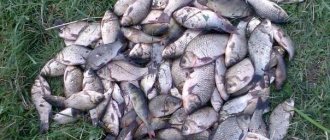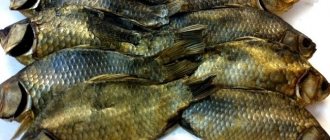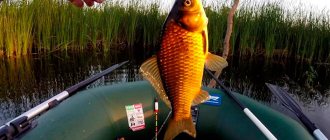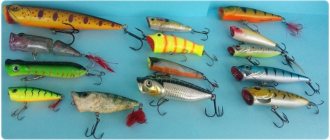Crucian carp is the most common type of freshwater fish, which is very popular all over the world. Crucian carp differs from other representatives in that it can easily tolerate the so-called “oxygen starvation”.
Most often it is found in quiet water, ditches, ponds, lakes or even swamps, although it can also be found in a river with a lot of water movement, but, according to all the rules, this fish chooses places with little water movement. Also, crucian carp is capricious in food and weather.
Catching crucian carp itself is a rather “mysterious” process; you yourself cannot know for sure whether a given specimen will fall for this bait or not. There are two types of crucian carp: silver and gold, people assign different names to them, instead of the ones that remain the same.
Fishing time and types of springs
A spring is used to catch crucian carp in warm water, when its activity in search of food is maximum. But crucian carp, like any other fish, does not like heat, so you need to catch it either early in the morning or late in the evening. At this time, she comes out of her daytime hiding places and actively feeds.
You can find different designs of springs, as well as their sizes, and therefore their weight. When choosing a suitable feeder, you need to take into account the casting distance. The further you plan to cast the tackle, the heavier it should be. The spring can be attached either rigidly or slidingly. In the case of a sliding fastening, a hollow tube must pass inside the spring through which the fishing line is passed. It would not be amiss if the spring was equipped with an anti-twist tube.
Autumn crucian fishing
In September-October, compared to the summer season, a decrease in its feeding activity is observed. This is due to a decrease in temperature of both air and water. Therefore, the efficiency of catching crucian carp in October is not very high. However, if you take into account some of the features of fishing during this period, then you can catch no less prey than in the summer.
Successful fishing for crucian carp in October is possible in deep reservoirs where there is a slight current. In such places, a feeder or half-bottom is used. According to experienced fishermen, in September crucian carp reaches its greatest activity by noon. Usually the bite ends by four o'clock in the afternoon. And since in September this fish feeds in significant concentrations, only choosing a good place for fishing can bring good catches. At this time, the bite is highly dependent on the weather. Crucian carp prefer clear days, so during strong winds or too much cloudiness, the catch is significantly reduced.
Existing Tools
There are two main options for attaching the spring to the equipment:
Sliding mount option
For this fastening you need to take a piece of fishing line about 40 cm long and 0.3 mm in diameter. A loop is formed on one side of the segment, after which the fishing line is passed through a hollow tube. After this, the feeder is locked, and a carabiner is attached to the loop. This type of fastening has a number of advantages, such as quick change of feeder and the ability to minimize snags;
Blind mounting option
This option involves attaching the feeder directly to the main fishing line. As a rule, the feeder is equipped with appropriate mounting points. Currently, even this method of fastening is not complete without fasteners and swivels, which allows for quick replacement of the “spring”. Leashes with hooks can be attached to the spring itself or at the point where the feeder is attached to the fishing line.
The rod should be selected depending on the fishing conditions and casting distance. Its length can be in the range of 2.5-3.5 m or more. The test load depends on the weight of the feeder and, when fishing in stagnant water, and crucian carp is mainly caught in stagnant water, it can be within 40 g. A spinning reel can have a size from 2000 to 4000. The diameter of the fishing line can be from 0.25 to 0 .3 mm. Hooks - No. 7 and No. 8.
The most effective baits
Different baits are used at different times of fishing. In spring they most often use:
- maggot
- bloodworm
- worm
- Be sure to add a bite activator.
In summer it is used:
- worm
- steamed peas
- corn
- Styrofoam
- Be sure to add a bite activator.
Foam for crucian carp comes in different colors and can come with different aroma, but don’t forget that you should always have several options for bait, so crucian carp may not take corn at all one day, but with great passion they will peck on a worm or peas.
Making a spring
You can make a spring of various designs and shapes. There are cylindrical, conical and curved springs, with and without a sinker, small and large. The smallest structure has a length of 2 cm and a diameter of 1 cm. The largest feeders are limited in size to 6 cm. These are optimal limits, beyond which there is no point in climbing.
To avoid the hassle of making it, you can buy such a feeder in fishing stores. As practice shows, homemade structures made by experienced crucian fishermen are more catchy. This is due to the accumulation of certain knowledge, which allows us to make a more successful design that takes into account all the intricacies of fishing.
Spring feeder, made by hand. I was fishing. Fishing.
Types of equipment
There are several types of springs:
- Cone-shaped. This spring is shaped like a cone, and it was also given the name “tumbler”. It cannot be used in reservoirs overgrown with algae, or in reservoirs with a muddy bottom, as there is a possibility that this spring will get tangled or break.
- A spring in the shape of an ellipse or an “olive”. This spring comes with a built-in weight, it is very convenient and practical. If the tackle is located between the base and the sinker itself, depending on the type of fishing, then this type is excellent for muddy bottoms. It has good sensitivity and is light in weight, so it can be cast over long distances without any difficulty.
The spring is especially good in still water, but its effectiveness is not lost in currents. Usually, before fishing, it is advised to dip the spring in shaking, this way it will have a more natural appearance. It is not necessary to buy a float in the store; you can also use a small piece of foam, which will not have any effect on the catch.
Bait for crucian carp
A spring is a special design of feeders that should be filled with bait every time you cast. The outcome of the fishing will depend on how correctly all the ingredients are selected. The easiest way, if you have the financial means, is to purchase ready-made mixtures in dry form and then prepare them near a pond, adding a little water. In this case, fishing can be quite expensive. In order not to pay extra, you can stand near the stove for a while and get the original mixture, no worse than the store-bought one. As a result of this approach, many recipes were born. Moreover, most of them are quite catchy, since they take into account the taste preferences of crucian carp.
When preparing homemade bait recipes, three main types of cereals are used - pea, wheat and corn. Porridge is cooked from them, after which other ingredients are added to improve the taste and aroma. In addition, the porridge must have a specific consistency, which would allow it to be kept in the feeder for a certain time. Substances that enhance the aromatic properties of the bait are added to the main composition of the bait. Quite often they add makukha (sunflower cake), which has a persistent aroma. In addition, crucian carp are interested in baits with dill, garlic, and cinnamon flavors. It is possible to use artificial flavors, but they are easy to add, which can scare off the crucian carp.
The density of the bait should be such that it does not fall out of the feeder after hitting the water, but is washed out of the feeder after hitting the bottom. There are cases when a spring is used for fishing in the current. This also requires preparing the appropriate consistency for the bait, since the current will wash the bait out of the feeder much faster.
Used tackle and fishing technique
Tackle for fishing with a nipple is not particularly aesthetically pleasing. Its main task is to cope with the pressure of such strong fish as carp or carp. Tackle for catching carp on a nipple includes the following elements:
- a powerful fiberglass rod about 4 m long and a weight of up to 200 g;
- inertia-free or inertial coil;
- monofilament line with a diameter of 0.45 mm;
nipples.
The purchased version of the pacifier works no worse than the homemade one.
A long, powerful rod allows you to cast the tackle over a long distance, which is sometimes necessary when fishing on a large river. Fiberglass rods are better suited for this fishing method. Many anglers dislike fiberglass fishing rods due to their heavy weight and slow action. However, in this case, the weight and structure of the rod do not play any role, since during fishing the tackle lies on the racks. In addition, fiberglass products are much cheaper, and their strength characteristics are at the highest level.
Tackle for fishing with a nipple can be equipped with either a spinning reel or an inertial reel. The main advantage of the inertial version is direct traction, which ensures high reliability of the gear. The downside is that it is quite difficult to master the casting technique with this type of reel, which is why long casts may not be possible.
Attention! With a spinning reel it will be much easier to cast a nipple, however, such products are not particularly reliable and when catching large fish on a heavy feeder they quickly break down. Some fishermen use thick braided cord rather than monofilament line in this rig, which is not entirely correct
“Braid” with a low coefficient of elongation - this is fraught with the fact that during fishing, the carp tears its lips and comes off the hook
Some fishermen use thick braided cord rather than monofilament line in this rig, which is not entirely correct. A “braided line” with a low elongation coefficient is fraught with the risk that during fishing, the carp tears its lips and comes off the hook.
The technique for catching carp on a nipple is quite simple. The fisherman fills the feeders with bait and casts several tackles in the most promising area of the reservoir. Each tackle is located at a distance of 20–30 m from each other, which is necessary to prevent tangling of the tackles while fishing for the trophy. After casting, the rod is installed on the stand, and the reel clutch is loosened.
The friction of the reel when fishing for carp on a nipple must be weakened, otherwise there is a high probability of losing the tackle when biting a large fish.
The bite of a carp is easy to notice by the trembling of the rod tip or the sound of the friction brake of the reel. At night, you can install an additional bite alarm on the tackle in the form of a bell or an electronic sensor.
Seeing a bite, the fisherman hurries to the rod and pulls the trophy ashore. After which he charges the feeder again and continues fishing. It is advisable to have a large landing net next to the rods, which can be useful in case a large specimen is bitten.
Bait
For greater efficiency, it is necessary to use not only bait, but also bait, which is located on the hooks. Widely used baits when fishing for crucian carp can be:
- maggot;
- dung or earthworm;
- bloodworm;
- corn, including canned corn;
- steamed peas.
A spring works well if foam is used instead of the baits described above. These can be either colorless balls or multi-colored ones with a certain aroma.
Types of bait
In addition to groundbait, bait also plays an important role. The product should be placed on hooks, which will additionally interest the fish.
It is best to give preference to these delicacies:
- Worms (earthen or dung - there is no difference).
- Motyl.
- Maggot.
- Steamed peas.
- Corn.
Sometimes foam plastic also shows good results, on which crucian carp bite perfectly. True, in this case it is necessary to choose the brightest balls, and also flavor them in order to interest the fish.
Spring fishing techniques and tactics
To begin with, you should find a promising place where the crucian carp spends the most time. Naturally, in clear water crucian carp are unlikely to be interested, especially if they have their own enemies in the form of perch or crucian carp. Therefore, he tries to stay close to thickets or rubble of fallen trees, as well as snags. Having decided on a place, they carry out preliminary feeding of the fish, which is expressed in several, one after another, casting of the feeder with food. After this, you can begin the fishing process. To do this, each hook is equipped with the appropriate bait. To prevent the hooks from overlapping when casting, they are stuck into the bait. After hitting the bottom, when the process of washing out the food begins, the hooks with bait are released. It will be better if the hooks are suspended, that is, have positive buoyancy. A sandwich consisting of a foam ball and bait (worm, bloodworm or maggot) can provide this. After the tackle is thrown, it is placed on a stand, after which a bite alarm is attached. This can be either a regular bell or an electronic, more advanced alarm.
Due to the fact that the fish are feeding, all casts should be made to the same place. If you don’t do this, but scatter all the food over a large area, then you shouldn’t expect a good bite, much less a catch.
The specificity of fishing with a spring, especially when it is rigidly attached to the fishing line, is that the crucian carp hooks itself under the influence of the weight of the feeder. Therefore, there is no need to do any cuttings. If the bite alarm goes off, then the crucian carp is already on the hook. In order for self-cutting to occur without misfires, sharp hooks should be used, preferably imported, branded ones.
The fisherman's task is to carefully pull the caught crucian carp ashore. As a rule, large individuals are rarely found, so you will have to pull out small crucian carp, only about 100 g, but this is not a problem.
In any case, it is better to have a small landing net, since the leads can be very thin, and even a small specimen can break it when fished out.
Fishing with a float rod
In October, crucian carp rarely comes close to the shore. At this time of year, every detail in the equipment is relevant: both a small hook and a nozzle with the correct weight are important. Fishing for crucian carp in October with a float rod is carried out both from the shore and from a boat. In the first case, the tackle should be quite long - up to seven meters. In this case, the float should weigh about two grams. A lightweight carbon fiber rod with a spinning reel and a fishing line with a diameter of 0.14-0.2 mm is best suited. Hooks can be selected from number two to number four, light in color.
An important point is the correct choice of load, since crucian carp take the bait very carefully in the fall. And if the fish feels resistance, it immediately throws it out. The bite of crucian carp in this season is typical only for it: at first the float begins to tremble slightly, then, abruptly lying on the water, it moves to the side. This is the most ideal moment to hook.
Fishing technique
The specifics of catching crucian carp using the crucian carp killer rig looks quite simple and is practically no different from fishing with a feeder.
- First you need to conduct a visual inspection of the water area and identify a promising area for casting.
- Next, you need to determine the depth in the reservoir by dragging a sinker along the bottom. To fix any unevenness, holes or other terrain features, you will need to use a marked float.
- When making the first cast, you do not need to use hooks. To improve the accuracy of delivery of equipment, it is recommended to be guided by a horizontal plane or an object on the opposite side of the reservoir.
- For reliable fixation, the rod is placed on a stand, and the fishing line is clipped to the spool.
By following these tips, you can send the spring exactly where you originally planned. When performing subsequent casts, the blank is held in a vertical position without tension until the line is on the clip and the impact occurs. Next, the rod needs to be lowered forward and placed on the stand. Such actions will eliminate the need to constantly rewind the fishing line after lowering the springs to the bottom.
Considering the large weight of the equipment, it will be problematic to determine a weak and sluggish bite of crucian carp. The key signal that the fish has been successfully hooked is a sharp jerk with slack in the line.
A properly configured “crucian carp killer” provides excellent results when catching this inhabitant of the depths, but deprives the angler of the main fascination and excitement of fishing. The technique is intended for catching large trophies, so fans of sport fishing are better off considering the classic feeder option.
Catching crucian carp with a spring in autumn and summer: installation and video, as well as preparing bait
Of all the fishing methods, fishing for crucian carp with a spring is considered one of the most effective. In addition, this is one of the cheapest methods, since there is no need to spend money on expensive reels, rods and the like.
In addition, there is no difficulty in making a spring at home, since its structure is very simple. It consists of leashes to which hooks are attached, a main fishing line with a diameter of about 0.4 mm and a spring 5 cm long and 2 cm in diameter.
A spring and leads are attached to the main line. Moreover, to prevent the leashes from getting tangled, you need to put on a special cambric and remove the leashes through it
It doesn’t matter at all what shape of spring you attach, the main thing is to place the bait correctly and insert the hooks into it. The tackle with bait is thrown into the water - and all that remains is to wait for the crucian carp to bite
Preparation of bait
Despite the fact that stores have a wide variety of ready-made baits for catching crucian carp, it is still better to make it yourself.
Experienced fishermen consider this a special ritual, experimenting with the ingredients each time. The bait may include dry ingredients, a mixture of various cereals and flakes.
For example, you can mix ground biscuits, ground sunflower seed cake and bran.
You can also use a mixture of grated sunflower seeds and gray bread, which must be softened with water. To prevent the bait from spoiling, you can add a small amount of salt to it.
Of those baits that need to be prepared in advance, the most popular are different types of porridge. It could be a mix of different porridges, or maybe one with the addition of other ingredients.
For example, boiled corn grits and sunflower seeds, pea grits mixed with semolina. You can add bran, crackers, bread, as well as any store-bought bait to the porridge.
Consider the fact that for calm water you can make the bait softer, but if you are fishing in the current, your bait should be harder so that the current of water does not wash it away.
Don't forget to add flavorings to your bait. They can be either store-bought or home-made. The most popular natural flavorings are garlic, honey, Vietnamese balsam “Star” and kerosene.
Please also take into account that each season requires its own flavorings: in cold weather it is better to use those that have a weak protein odor, and in the summer it is better to take sweet ones or with a pronounced aroma. Making a spring for fishing for carp and crucian carp - a practical guide to the structure of tackle and preparation of bait
Making a spring for fishing for carp and crucian carp - a practical guide to the structure of gear and preparation of bait.
A small instruction on choosing the right leash for crucian carp using a feeder and float in the next article.
Carp Feeder Method
An analogue of fishing with a spring is the carp feeder Method. This feeder is very popular among sports fishermen, as it is very easy to use. Absolutely any bait is suitable for such a feeder, as is groundbait. It is better to use it in calm water.
This feeder is attached to a fishing line and there are two ways to use it:
- Sliding feeder. In this case, the feeder calmly slides along the fishing line and the fish that is hooked does not at first feel that it has been caught. When using this method, make sure that the rod stands are very strong, since the bite usually occurs unexpectedly and is quite strong.
- Fixed feeder. Here the feeder is attached to the fishing line, so that the caught fish cannot swim away anywhere, as the process of self-cutting occurs. This method requires a fairly strong fishing line, and the usual leashes will not work here.
How to increase your fish catch?
Over 7 years of active fishing, I have found dozens of ways to improve the bite. Here are the most effective ones:
- Bite activator. This pheromone additive attracts fish most strongly in cold and warm water. Discussion of the bite activator “Hungry Fish”.
- Increased gear sensitivity. Read the appropriate manuals for your specific type of gear.
- Pheromone-based lures.
